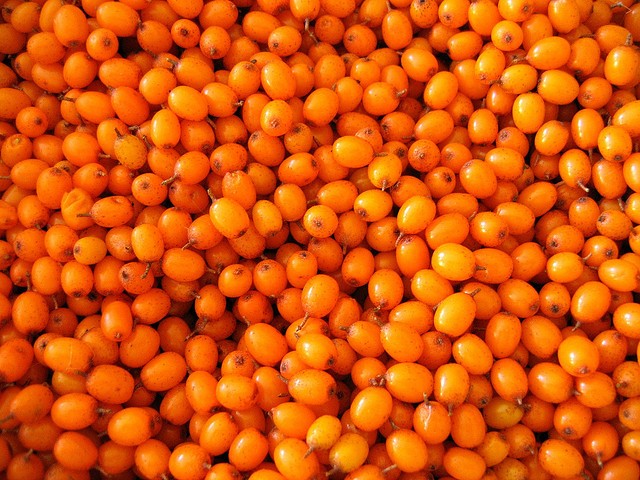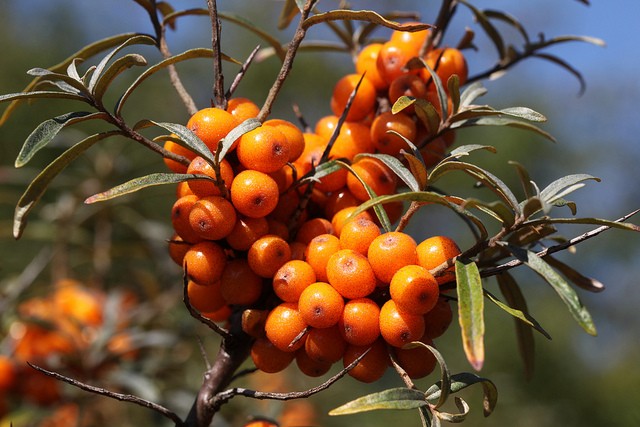- Make It Yourself Lavender Heart-Shaped Bath Bombs!
- 20 Things You Never Knew About “Down There”
- 12 Best Foods For Those Suffering From Arthritis Pain
- 12 Personal Hygiene Mistakes Almost Everyone Makes (Mom Never Told You About #4!)
- 15 Medicinal Plants And Herbs From The Cherokee People
- 12 Mind-Blowing Benefits Of Drinking Coconut Water During Pregnancy
- 12 Outstanding Winter Foods That Won’t Fatten You Up Like A Christmas Turkey
The Super Anti-Aging Oil You’ve Never Heard About

You might think you’ve heard it all when it comes to healthy oils, but there is one that, although it’s been used for centuries in Europe and Asia, is little known in America. However, due to its many benefits and its powerful anti-aging action, it is quickly gaining in popularity. What is this oil? Sea buckthorn oil.
Although the name suggests otherwise, this oil does not come from the sea. In fact it doesn’t have anything to with the ocean. This oil comes from a shrub that grows in the mountains of Asia and Europe. Its scientific name is hippophae rhamnoides, which literally means, “tree that makes the horses shine.” This is because it has been used since ancient times to make a horse hair smooth and shiny. It was also used to cure blindness that affected horses.
Although this shrub is believed to have originated in the Himalayas, it’s known that it was used by the Greeks. It appears in ancient Greek mythology and Tibetan texts, as well as the Indian Materia Medica. Sea buckthorn oil is even noted in the bloody histories of Genghis Khan, so this oil has been used for a very, very long time.
We get two different oils from the same plant: oil from the seed and oil from the fruit. They both come from the small, yellowish, nutrient rich berries, which are smaller in size than a blueberry. Of course the seed oil comes from the seeds and the fruit oil comes from the fleshy pulp of the fruit. Although both types of oils can work wonders, most people find that the oil from the berry is best for topical applications and the oil from the seed gives the most benefits when taken internally.
Continue to Page 2

Sea buckthorn berry is quickly becoming as popular as pomegranate and acai berry due to its incredible nutritional profile. With over 190 nutrients and phytonutirents, sea buckthorn has more than 12 times the vitamin C of an orange, as much vitamin E as wheat germ, three times the vitamin A of carrots, and four times more SOD (superoxide dismutase), an enzyme that helps prevent the damage the free radicals, than ginseng. To top it all off, sea buckthorn oil is the only plant source that has omega-3, 6, and 9!
The good news here is that you can use the oil both internally and externally. This oil is now perhaps best known in today’s market for its super healing and rejuvenating effects in the area of skincare. It’s a terrific exfoliator and natural cleanser that helps cuts and burns, and repairs all types of skin damage. Applying sea buckthorn oil to your skin regularly can dramatically slow the signs of aging by nourishing your skin tissues. Find out other oils for skin care.
Vitamin B12 has been shown to slow the effects of cognitive decline and sea buckthorn oil is high in this important vitamin. The high levels of omega-3 in this oil also contribute to healthy brain function.
Sea buckthorn oil can also help you manage your weight. Experts claim that the fatty acids in this oil helps tell your body to move fat to muscles and to stop storing it. Dr. Mehmet Oz says that sea buckthorn oil can help keep excess weight off for longer periods of time than other types of weight loss programs or foods.
If you suffer from GERD, have stomach ulcers, or have other types of stomach issues such as dyspepsia or chronic constipation, then sea buckthorn oil is for you. It helps soothe the mucosal tissue in your digestive tract, which helps soothe all sorts of digestive issues.
This oil can provide some serious relief from dry eyes as well, which is common in menopausal women and older adults.
Continue to Page 3

Also, due to the high antioxidant power of sea buckthorn oil, it can provide some serious protection from liver damage. One animal study found that this herbal oil reduced the concentrations of aflatoxins in the liver, which can stop these toxins from having adverse effects on the liver. Another study found that this oil helped to normalize the serum bile acids in the liver and normalize its enzymes. This study was published in the Journal of Clinical Science.
You can apply this oil topically or take it internally to get all the benefits. Orally, the dose is typically 5 milligrams, twice per day. Topically, simply apply it liberally to the affected area or the area you would like to receive its anti-aging compounds, such as around the eyes and lips.
If you decide to consume sea buckthorn oil internally, don’t be concerned if your urine turns a red or very dark yellow; this is normal.
As you would imagine, extracting sea buckthorn oil is a difficult process and the manner in which this is done will affect the quality, as well as the potency of the oil. Cold pressing might be thought to be ideal, but the actual extraction rate is poor. Hot pressing or solvent extraction either contaminates the oil with toxic solvents or the heat destroys the oils benefits.
SEE ALSO: The Truth Behind Olive Oil
Look for oil that has been extracted using a CO2 extraction method. Liquid CO2 is used to pull out oil, which allows for more extraction and no contamination.
Please note that if you have kidney, liver, or intestinal problems, do not consume sea buckthorn oil. If you have any doubts, or if you are on any type of medication, before you take sea buckthorn oil internally, consult your doctor. Although it is believed to be safe for most people, you should be certain that there will be no drug interactions.
Continue to Sources
Sources:
Agrawala, P. K. and Adhikari, J. S. Modulation of radiation-induced cytotoxicity in U 87 cells by RH-3 (a preparation of Hippophae rhamnoides). Indian J.Med.Res. 2009;130(5):542-549.
Aitzetmuller, K. and Xin, Y. [Sea buckthorn and sea buckthorn oils–recent developments in China and central Asia]. Nahrung 1999;43(4):228-232.
Andersson, S. C., Rumpunen, K., Johansson, E., and Olsson, M. E. Tocopherols and tocotrienols in sea buckthorn (Hippophae rhamnoides L.) berries during ripening. J.Agric.Food Chem. 8-13-2008;56(15):6701-6706.
Arimboor, R., Kumar, K. S., and Arumughan, C. Simultaneous estimation of phenolic acids in sea buckthorn (Hippophae rhamnoides) using RP-HPLC with DAD. J.Pharm.Biomed.Anal. 5-12-2008;47(1):31-38.
Backhouse, N., Rosales, L., Apablaza, C., Goity, L., Erazo, S., Negrete, R., Theodoluz, C., Rodriguez, J., and Delporte, C. Analgesic, anti-inflammatory and antioxidant properties of Buddleja globosa, Buddlejaceae. J.Ethnopharmacol. 3-5-2008;116(2):263-269.

































Gabe
Feb 16, 2015 at 1:31 pm
Omega-7 fatty acids are a class of unsaturated fatty acids in which the site of unsaturation is seven carbon atoms from the end of the carbon chain. The two most common omega-7 fatty acids in nature arepalmitoleic acid and vaccenic acid. Rich sources include macadamia nut oil and sea buckthorn oil.
Olivia Stone
Feb 20, 2018 at 6:25 pm
this looks really great! it is like we have found the fountain of youth! I cant wait to make a facial cream with this and with my added Solvaderm, have a firmer skin. thanks for this
Jessica Moore
Apr 21, 2018 at 6:53 pm
Sea Buckthorn is amazing!